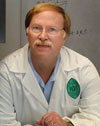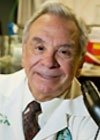

DONALD P GAVER
Alden J “Doc” Laborde Professor and Department Chair of Biomedical Engineering
dpg@tulane.edu | (504) 865-5150
Dr. Gaver directs research in Tulane’s Biofluid Mechanics Laboratory, which aims to develop an understanding of the interrelationship between the mechanical and physicochemical behavior of biological systems. These investigations focus on the pulmonary system with the goal of developing improved therapies for pulmonary diseases such as infant and acute respiratory distress syndrome (RDS and ARDS) and the prevention of ventilator-induced lung injury (VILI). At present, his research focuses on study of the dynamic interplay between transport processes, interfacial phenomena and fluid stresses that alter the pulmonary epithelial structure and function during respiratory distress. In addition, his research extends to the design of optimized microfluidic devices for biosensor technology. These integrated studies bring together basic and applied scientists (including computational scientists), device developers and physicians to study problems of high clinical importance.

DIANE BLAKE
Professor of Biochemistry & Molecular Biology
Tulane Cancer Center Contributing Member
blake@tulane.edu | (504) 988-2478
Dr. Blake received her B.S. in Biochemistry in 1972 from Ohio State University in Columbus, Ohio. She then moved to the University of Illinois at Urbana-Champaign to study proteoglycan biosynthesis/structure with H. Edward Conrad and received her PhD in Biochemistry in 1977. After a 4-year postdoctoral fellowship studying lectin biochemistry and glycoprotein synthesis with Irwin J. Goldstein at the University of Michigan, Ann Arbor, MI, she joined Miles Laboratories as a Research Scientist in 1981. In 1983 she took a faculty position at Meharry Medical College in Nashville, TN, where she remained for 9 years. She came to Tulane in 1993 and is now Professor of Biochemistry. Dr. Blake has published over 50 papers in the areas of glycoprotein/proteoglycan biochemistry and protein-ligand interactions. She served for 5 years as a Member of the Advisory Panel for Cell Biology for the National Science Foundation and recently was a Panel Member for their Biocomplexity initiative. She has also served on Review Panels of the Environmental Protection Agency and performed ad hoc reviews for the National Institutes of Health, the Wellcome Trust (UK), and the North Carolina Biotechnology Center.
She reviews regularly for Investigative Ophthalmology and Visual Sciences and Analytica Chemistry. One area of Dr. Blake's research is focused upon a study of extracellular matrix and cell-matrix interactions. Her most recent projects have included signal transduction via extracellular matrix receptors, and research on the effects of extracellular molecules on cell migration and proliferation. She has concentrated upon those extracellular matrix molecules that influence the behavior of vascular endothelial cells. A practical outcome of her experiments has been the development of new drugs (based on extracellular matrix molecules) that inhibit the process of angiogenesis. Such angiogenesis inhibitors have applications in the control of both cancer and ocular disease. A second area of active research in Blake's laboratory is the development of antibody reagents that can be used to assess human exposure to heavy metals. Some of the antibodies she has developed for this project also have applications in cancer prognosis and therapy.

RICARDO CORTEZ
Pendergraft William Larkin Duren Professor of Mathematics
Director of the Tulane Center for Computational Science
rcortez@tulane.edu | (504) 862-3436
Many different types of microorganisms, such as bacteria, generate interesting fluid flow around them as they move their flagella in helical or undulatory ways. As measuring devices become more accurate in the laboratories, researchers are able to observe intricate flows generated by either single or multiple organisms. New flow patterns have been observed when organisms are near a flat surface like the bottom plate of the microscope. Computational models of these flows provide additional insight into how these flows arise, what they might look like in the space between organisms, and the role they might play in the overall motion of swarms of organisms. Similar techniques are also applied to the motion of cilia or passive organism appendages.
Prof. Cortez’s research focuses on developing and analyzing computational methods for the simulation of biological flows. Of particular interest are collaborative investigations of flows generated by swimming microorganisms, cilia, and other compliant, flexible boundaries in a fluid with an emphasis on accurate simulations around the boundaries.

ROBERT GARRY
Professor
rfgarry@tulane.edu | (504) 988-2027
Dr. Garry received his B.S in Life Sciences with a minor in Chemistry from Indiana State University in 1978. He then carried out doctoral studies in Microbiology at the University of Texas at Austin under the direction of Dr. Marilynn R.F. Waite and received his Ph.D. in 1978. His dissertation was entitled: "Intracellular sodium and potassium and the regulation of gene expression in virus-infected and virus-transformed chick cells." He carried out postdoctoral research in virology at UT Austin under the mentorship of Dr. Henry R. Bose, Jr. In 1983 Dr. Garry was appointed Assistant Professor of Microbiology and Immunology at Tulane University School of Medicine in New Orleans, Louisiana. In 1985 he was Visiting Professor of Pathology at the University of Southern California working with Dr. Suraiya Rasheed. Dr. Garry spent 1991 as a Visiting Professor of Molecular Biology at the University of Hamburg working with Dr. Gebhard Koch. Since 1993 he has been Professor of Microbiology and Immunology at Tulane Medical School. Dr. Garry has published over 100 papers in the area of retrovirology. Research in the Garry Laboratory focuses on a number of aspects of retroviral pathogenesis. Investigations have found that HIV induces a number of defects in plasma membrane ion transport, which could account for the loss of CD4+ T-cells in AIDS patients. Another research interest is the molecular characterization of an isolate of HIV from a patient who died of AIDS in 1969. This is the earliest confirmed case of AIDS in the United States. In addition, the lab has discovered a retrovirus named human intracisternal A-type retroviral particle (HIAP), which appears to be involved in systemic autoimmune diseases and idiopathic CD4 T-lymphocytopenia. More recently, the lab obtained evidence for the existance of a human endogenous retrovirus named human mammary tumor virus (HMTV), which is a close homolog of a virus which causes breast cancer in mice.
Dr. Garry is currently managing a consortium of scientists who are developing countermeasures, including diagnostics, immunotherapeutics and vaccines, against Lassa virus, Ebola and Marburg viruses, and other high consequence pathogens. Our team has produced Lassa fever and Ebola point-of-care and confirmatory diagnostics based on recombinant proteins. A combination of human monoclonal antibodies has been shown to rescue 100% of monkeys even when treatment is initiated at an advanced stage of disease. Studies on a combination Lassa fever and Ebola vaccine for use in West Africa have been initiated. Productive collaborations have been exploited to deepen understanding of the natural history of viral hemorrhagic fevers while providing training for West African scientists and further developing research and clinical trial infrastructure in Sierra Leone and Nigeria.

L GABRIEL NAVAR
Professor and Department Chair of Physiology
Co-director of the Tulane Renal and Hypertension Center of Excellence
navar@tulane.edu | (504) 988-2594
Dr. Navar, professor and chair of the Tulane Department of Physiology, is a co-director of the Tulane Renal and Hypertension Center of Excellence in the School of Medicine. The center, which houses several state-of-the-art core facilities – including an Animal & Gene-Targeted Core, a Molecular, Imaging, & Analytical Core and a Mouse Phenotyping Core – provides unique research opportunities in an enriched environment where basic science discoveries can be translated to the clinical arena. Researchers from various departments across Tulane University collaborate under Dr. Navar’s guidance on patient-oriented studies of the causes and treatment of hypertension. In his own laboratory, investigations focus on hormonal and paracrine mechanisms that regulate renal hemodynamics, glomerular filtration rate (GFR) and sodium excretion. Intense activity is also focused on the pathophysiology of hypertension and the role of the intrarenal renin angiotensin system (RAS) in altering kidney function to lead to in angiotensin II dependent hypertension. These studies have revealed much about hypertension and paved the way for more accurate methods to assess the efficacy of medications in patients, which is vital to preempting serious complications of the disorder such as organ damage.
